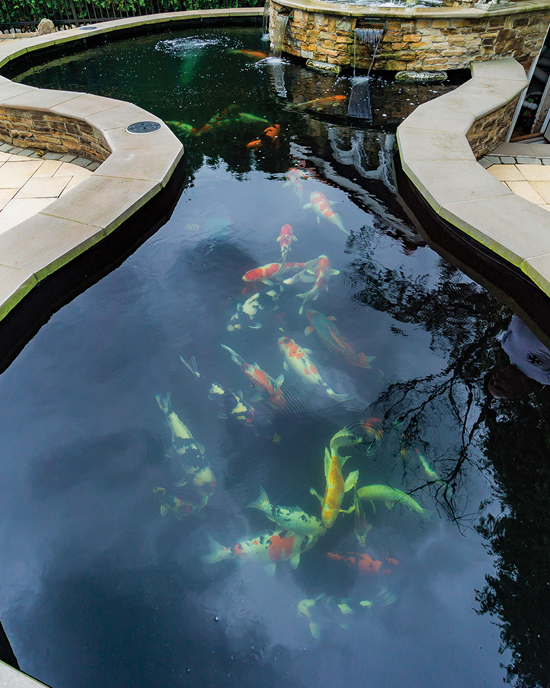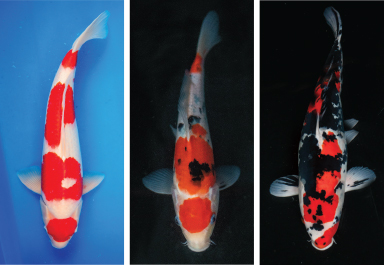
For koi enthusiasts, traveling to Japan, the birthplace of koi fish, is a once-in-a-lifetime experience. As koi dealers, we are spoiled and usually get to travel to Japan at least once a year. After five years of going on koi-buying trips, we have been lucky to learn from the top breeders about what to look for when picking out koi.
At the end of the day, the koi you should pick is the one you like the most. But frequently, customers will ask me what they should be looking for when picking out a koi from one of our tanks, so I share with them some of these general rules, depending on what variety they are interested in. In every case, I always look for their reaction as I walk them through our greenhouses, because when we walk up to a tank, there will usually be one or two koi that catch their eye immediately. More often than not, that’s the fish they end up purchasing.
The Holy Trinity of the koi world is the Gosanke class: the Kohaku, Sanke and Showa.
Kohaku
“Koi appreciation starts with the Kohaku and ends with the Kohaku” – Unknown. The Kohaku, pronounced “ko-hah-ku,” is a white (Shiroji) koi with orange (Beni) patches. When picking out a Kohaku, one of the most important things to look for (besides good health, of course) is a good, clean Shiroji. When breeding koi, it’s significantly more difficult to get a pure Shiroji than it is to get a good Beni. For this reason, a Tancho Kohaku koi with a nice, bright white can cost as much as a mortgage payment on a house — and sometimes even more.
For the Beni on a Kohaku, you generally do not want the coloration to extend past the eyes — although a button nose is fine and adds personality to the koi. An interesting feature some Kohaku have is Kuchibeni, or “red lipstick.” Kuchibeni refers to Beni on the lips of the koi that resembles lipstick.On a Kohaku, the Beni is the main focus, but you don’t want it to overwhelm the fish, because you still want to be able to appreciate the Shiroji. This is the classic pattern of a koi and is usually found both in koi artwork and on the crowned Grand Champion of the All Japan Koi Show. Indeed, for more than 10 years, the Grand Champion has been a Kohaku or a Showa.
Showa
The Showa Sanshoku, usually shortened to Showa and pronounced “show-ah,” has a black body — although it may not necessarily look like it — with red and white markings across it. A Showa tends to have less Shiroji than Kohaku or Sanke, and its Sumi will wrap around the body, almost always present on the head, then extending past the lateral line.

Great Showa are very difficult to pick, especially as juveniles, because the Sumi tends to change unpredictably over time. Sometimes it will show up on some areas of the fish and disappear in other areas as the fish matures. A Tosai (one-year-old) Showa will look almost completely different in just a year or two. If you don’t want a Showa to change very much, it’s better to pick a mature one that is at least a Sansai (three-year-old).
Sanke
The Sanke (pronounced “sawn-kay”) is a white koi with orange patches and black peppered throughout the body. The black spots should be on the top of the body and not extend past the lateral line. Occasionally, black stripes will be on the fins or tail.
When picking a Sanke, it is pretty similar to picking a Kohaku — you don’t want the Beni to cover too much of the face. As for the Sumi, you want it to be peppered throughout the koi as evenly as possible. There will usually be more Sumi toward the tail of the koi and no Sumi on the head.
Other Varieties

A Kujaku is a metallic white koi with orange or red patches and black reticulation of the scales. It is believed to have originally been created by crossing the Goshiki with Hikari Muji in the 1960s. A very sought-after specimen is the Tancho Kujaku; a Tosai high-end example can easily go for over $5,000. Kujaku actually means “peacock” in Japanese, and although they don’t have colors like a peacock, they have a similar essence. They have a metallic shimmer to them that resemble peacock feathers, and some have a demeanor like them, too. The way they swim around our tanks is similar to the way our male peacocks strut around the farm.
An Ochiba Shigure (“oh-chee-buh she-goo-rah”) is most often just referred to as Ochiba, which means “leaves of fall on the water.” It is a blue or gray-bodied koi with a chocolate-brown or rust pattern. Ochiba koi will often have reticulation on the scales, which is also called a net pattern, like the Asagi. Doitsu Ochibas are some of the most beautiful and rare fish you can find.
The Bottom Line
Unless you are buying very high-end koi or plan on entering them into a koi show, personal preference rules all. My favorite koi in my personal pond is a Showa from Shintaro Koi Farm that my sister picked out and affectionately named Scarlet. I got Scarlet as an 18-inch Nisai (two-year-old), and while this fish is beautiful, it isn’t going to win any awards.Does it matter that Scarlet may not be a show winner? No. Does it matter that Scarlet is actually a male? No. What matters is that she is the first fish to greet you when you walk up to the pond, and she is so friendly that you can handfeed her. She has way too much Beni. Her Sumi is ink-black, but I’ve seen Sanke with more black on them. Her Shiroji is a clean white, but there isn’t enough of it. In any case, she is adored by my family, and because of the joy she gives them, I wouldn’t trade her for any other koi.


